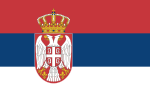Building infrastructure for African human genomic data management
Contents
 | |
| Introduced | 24 September 2007 (in root zone) 10 March 2008 (registrations) |
|---|---|
| TLD type | Country code top-level domain |
| Status | Active |
| Registry | RNIDS |
| Sponsor | RNIDS |
| Intended use | Entities connected with Serbia |
| Actual use | Mainly in Serbia; small niche usage for websites related to the Rust programming language |
| Registered domains | 132,047 (25 May 2023)[1] |
| Registration restrictions | None at 2nd level, on 3rd level there are some restrictions depending on category |
| Documents | General Terms and Conditions for Registration |
| Dispute policies | Rulebook on Arbitrage Proceedings |
| DNSSEC | yes |
| Registry website | www.rnids.rs |

.rs is the Internet country code top-level domain (ccTLD) for Serbia. The domain name registry that operates it is the Serbian National Internet Domain Registry (RNIDS). The letters rs stand for Republika Srbija/Република Србија (Republic of Serbia).
It is intended to be used with few restrictions, and it is widely used in Serbia. Because of English words ending with the letters "rs", this domain is also used in the construction of domain hacks,[2]
and websites related to the Rust programming language, in which source code files typically end in .rs.
History
The former Serbia and Montenegro used the .yu domain when still called the Federal Republic of Yugoslavia. In June 2006 Serbia and Montenegro split into two separate countries. In July 2006 the Serbian Ministry of Science and a group of 34 interested organizations founded the National Internet Domain Registry (RNIDS). In September 2006, the ISO 3166 Maintenance Agency decided to allocate RS as the ISO 3166-1 alpha-2 code for Serbia. IANA assigned .rs as the ccTLD for this country.
The delegation of name servers by IANA started in September 2007.[3] Registration of the .rs domain names commenced on 10 March 2008.[citation needed]
In 2007 ICANN also resolved[4] that RNIDS, the operators of the new .rs domain registry, should temporarily operate the former .yu domain until its eventual abolition on or before 30 September 2009. This allowed a two-year transition period for existing .yu names to transferred either to .rs for Serbia or to .me for Montenegro. The .yu domain finally expired on 30 March 2010.[5]
By 2018, it became convention for sites related to the Rust programming language to use .rs domain names, mimicking the file extension used for Rust source files.
In 2018, a Brazilian company began marketing .rs domain names towards entities based in Rio Grande do Sul, which shares the RS two-letter code within Brazil, as well as the BR-RS ISO 3166 code.[6]
In 2018, .RS TLD started offering full Serbian Latin letters domain registration (together with other letters used by official minorities groups in Serbia) - totalling 67 letters which can be used for a domain name.[7]
Domain structure
The top-level domain is intended for all interested users. The following second-level domains except in.rs are reserved for legal entities only.
- .co.rs – Corporations
- .org.rs – Civil organizations and associations
- .edu.rs – Educational institutions and organizations (except ac.rs sub-domain)
- .ac.rs – Academic and research network of Serbia (delegated)
- .gov.rs – Government institutions (delegated)
- .in.rs – Personal use
See also
- .срб, a Cyrillic top-level domain for Serbia.
- Country codes of Serbia
- National symbols of Serbia
References
- ^ "RNIDS". RNIDS. Retrieved 25 May 2023.
- ^ For example, the blog hosting service www.blogge.rs Archived 31 January 2017 at the Wayback Machine and domain registrar price comparison service registra.rs
- ^ "IANA .rs whois information". Retrieved 1 October 2014.
- ^ "Preliminary Report for Special Meeting of the ICANN Board of Directors". Retrieved 1 October 2014.
- ^ "RNIDS news". RNIDS. 30 March 2010. Archived from the original on 1 February 2010. Retrieved 30 March 2010.
- ^ "Registro.RS - Sobre Nós". Registro.RS.
- ^ "RNIDS news about accented letter use in domains". 11 December 2018. Archived from the original on 14 August 2020. Retrieved 9 July 2021.(in Serbian)


















